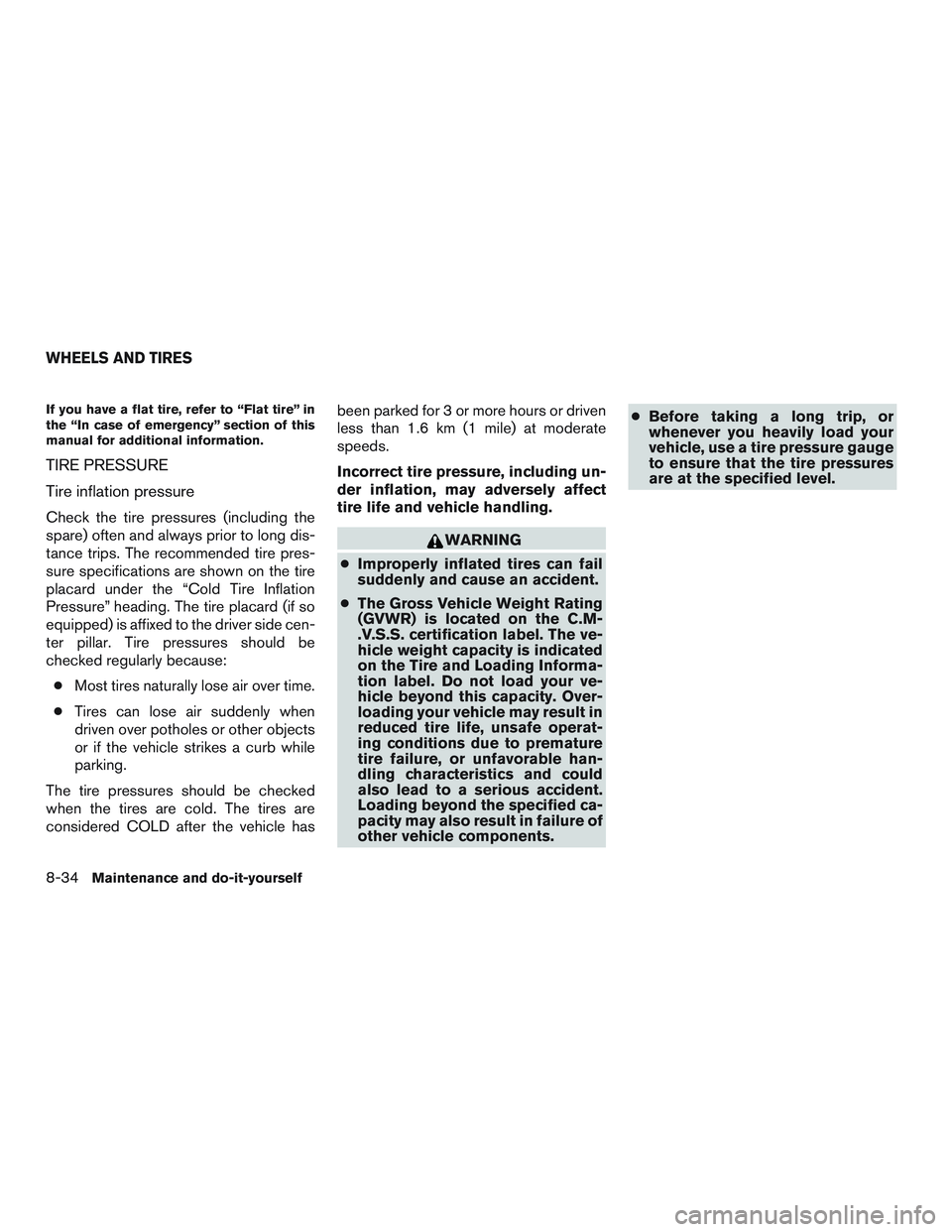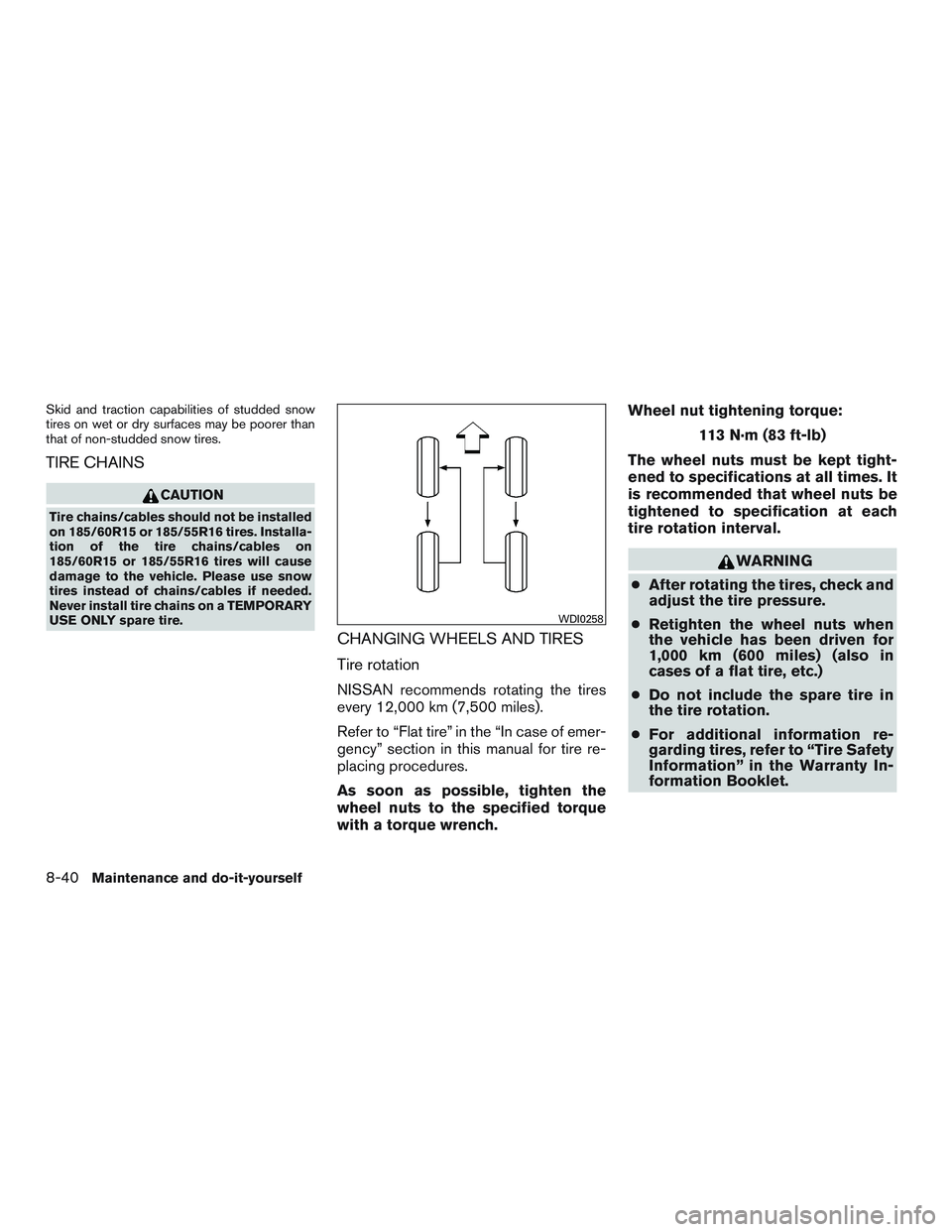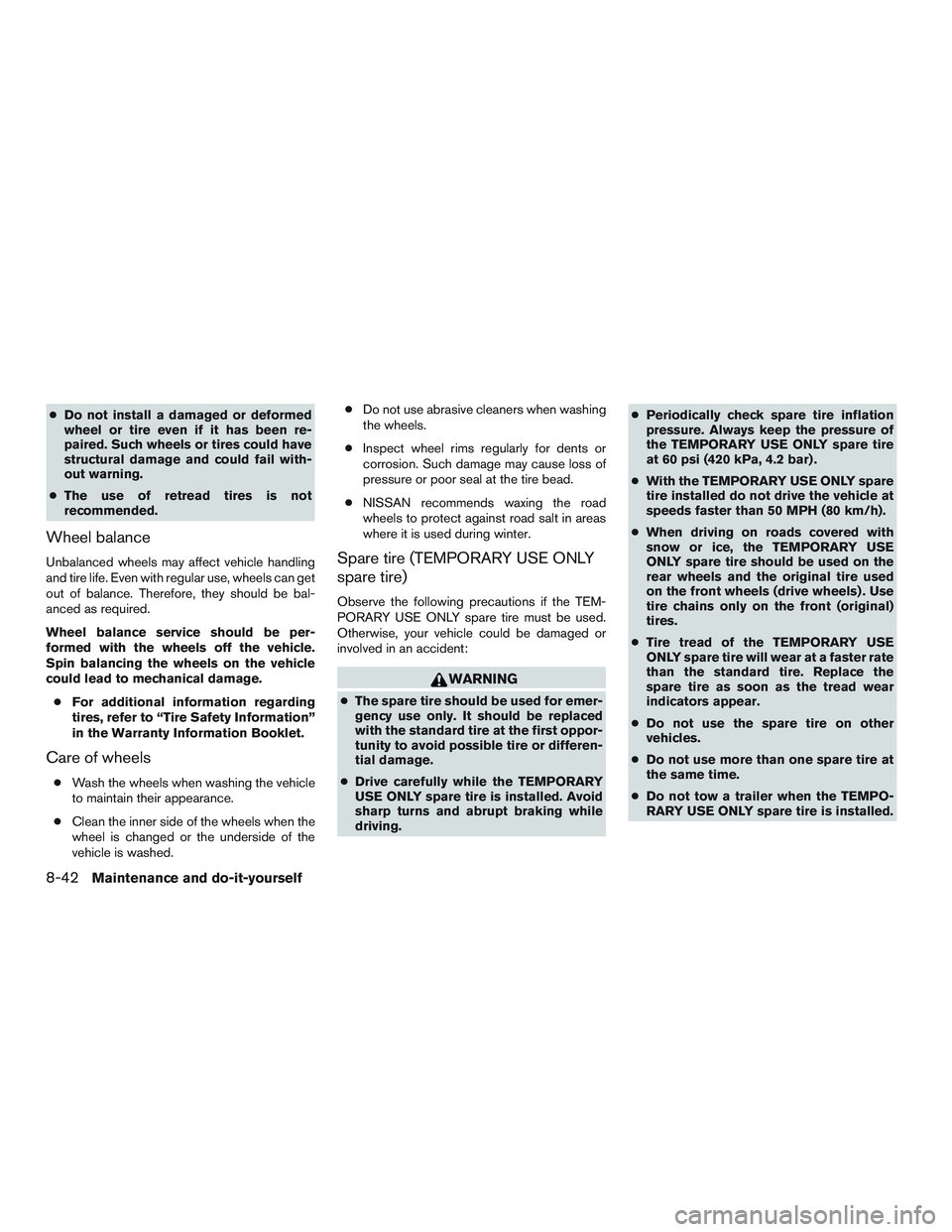2015 NISSAN MICRA spare wheel
[x] Cancel search: spare wheelPage 255 of 293

If you have a flat tire, refer to “Flat tire” in
the “In case of emergency” section of this
manual for additional information.
TIRE PRESSURE
Tire inflation pressure
Check the tire pressures (including the
spare) often and always prior to long dis-
tance trips. The recommended tire pres-
sure specifications are shown on the tire
placard under the “Cold Tire Inflation
Pressure” heading. The tire placard (if so
equipped) is affixed to the driver side cen-
ter pillar. Tire pressures should be
checked regularly because:● Most tires naturally lose air over time.
● Tires can lose air suddenly when
driven over potholes or other objects
or if the vehicle strikes a curb while
parking.
The tire pressures should be checked
when the tires are cold. The tires are
considered COLD after the vehicle has been parked for 3 or more hours or driven
less than 1.6 km (1 mile) at moderate
speeds.
Incorrect tire pressure, including un-
der inflation, may adversely affect
tire life and vehicle handling.
WARNING
● Improperly inflated tires can fail
suddenly and cause an accident.
● The Gross Vehicle Weight Rating
(GVWR) is located on the C.M-
.V.S.S. certification label. The ve-
hicle weight capacity is indicated
on the Tire and Loading Informa-
tion label. Do not load your ve-
hicle beyond this capacity. Over-
loading your vehicle may result in
reduced tire life, unsafe operat-
ing conditions due to premature
tire failure, or unfavorable han-
dling characteristics and could
also lead to a serious accident.
Loading beyond the specified ca-
pacity may also result in failure of
other vehicle components. ●
Before taking a long trip, or
whenever you heavily load your
vehicle, use a tire pressure gauge
to ensure that the tire pressures
are at the specified level.
WHEELS AND TIRES
8-34Maintenance and do-it-yourself
Page 261 of 293

Skid and traction capabilities of studded snow
tires on wet or dry surfaces may be poorer than
that of non-studded snow tires.
TIRE CHAINS
CAUTION
Tire chains/cables should not be installed
on 185/60R15 or 185/55R16 tires. Installa-
tion of the tire chains/cables on
185/60R15 or 185/55R16 tires will cause
damage to the vehicle. Please use snow
tires instead of chains/cables if needed.
Never install tire chains on a TEMPORARY
USE ONLY spare tire.
CHANGING WHEELS AND TIRES
Tire rotation
NISSAN recommends rotating the tires
every 12,000 km (7,500 miles).
Refer to “Flat tire” in the “In case of emer-
gency” section in this manual for tire re-
placing procedures.
As soon as possible, tighten the
wheel nuts to the specified torque
with a torque wrench.Wheel nut tightening torque:
113 N·m (83 ft-lb)
The wheel nuts must be kept tight-
ened to specifications at all times. It
is recommended that wheel nuts be
tightened to specification at each
tire rotation interval.
WARNING
● After rotating the tires, check and
adjust the tire pressure.
● Retighten the wheel nuts when
the vehicle has been driven for
1,000 km (600 miles) (also in
cases of a flat tire, etc.)
● Do not include the spare tire in
the tire rotation.
● For additional information re-
garding tires, refer to “Tire Safety
Information” in the Warranty In-
formation Booklet.
WDI0258
8-40Maintenance and do-it-yourself
Page 262 of 293

1. Wear indicator
2. Location mark
Tire wear and damage
WARNING
●Tires should be periodically inspected
for wear, cracking, bulging or objects
caught in the tread. If excessive wear,
cracks, bulging or deep cuts are found,
the tire(s) should be replaced. ●
The original tires have built-in tread
wear indicators. When the wear indica-
tors are visible, the tire(s) should be
replaced.
● Tires degrade with age and use. Have
tires, including the spare, over 6 years
old checked by a qualified technician
because some tire damage may not be
obvious. Replace the tires as necessary
to prevent tire failure and possible per-
sonal injury.
● Improper service of the spare tire may
result in serious personal injury. If it is
necessary to repair the spare tire, con-
tact a NISSAN dealer.
● For additional information regarding
tires, refer to “Tire Safety Information”
in the Warranty Information Booklet.Replacing wheels and tires
When replacing a tire, use the same size, tread
design, speed rating and load carrying capacity
as originally equipped. Recommended types and
sizes are shown in “Wheels and tires” in the
“Technical and consumer information” section of
this manual.
WARNING
● The use of tires other than those recom-
mended or the mixed use of tires of
different brands, construction (bias,
bias-belted or radial) , or tread patterns
can adversely affect the ride, braking,
handling, ground clearance, body-to-
tire clearance, tire chain clearance,
speedometer calibration, headlight aim
and bumper height. Some of these ef-
fects may lead to accidents and could
result in serious personal injury.
● If the wheels are changed for any rea-
son, always replace with wheels which
have the same off-set dimension.
Wheels of a different off-set could
cause premature tire wear, degrade ve-
hicle handling characteristics and/or in-
terference with the brake discs/drums.
Such interference can lead to de-
creased braking efficiency and/or early
brake pad/shoe wear. Refer to “Wheels
and tires” in the “Technical and con-
sumer information” section of this
manual for wheel off-set dimensions.
WDI0259
Maintenance and do-it-yourself8-41
Page 263 of 293

●Do not install a damaged or deformed
wheel or tire even if it has been re-
paired. Such wheels or tires could have
structural damage and could fail with-
out warning.
● The use of retread tires is not
recommended.
Wheel balance
Unbalanced wheels may affect vehicle handling
and tire life. Even with regular use, wheels can get
out of balance. Therefore, they should be bal-
anced as required.
Wheel balance service should be per-
formed with the wheels off the vehicle.
Spin balancing the wheels on the vehicle
could lead to mechanical damage.
● For additional information regarding
tires, refer to “Tire Safety Information”
in the Warranty Information Booklet.
Care of wheels
● Wash the wheels when washing the vehicle
to maintain their appearance.
● Clean the inner side of the wheels when the
wheel is changed or the underside of the
vehicle is washed. ●
Do not use abrasive cleaners when washing
the wheels.
● Inspect wheel rims regularly for dents or
corrosion. Such damage may cause loss of
pressure or poor seal at the tire bead.
● NISSAN recommends waxing the road
wheels to protect against road salt in areas
where it is used during winter.
Spare tire (TEMPORARY USE ONLY
spare tire)
Observe the following precautions if the TEM-
PORARY USE ONLY spare tire must be used.
Otherwise, your vehicle could be damaged or
involved in an accident:
WARNING
● The spare tire should be used for emer-
gency use only. It should be replaced
with the standard tire at the first oppor-
tunity to avoid possible tire or differen-
tial damage.
● Drive carefully while the TEMPORARY
USE ONLY spare tire is installed. Avoid
sharp turns and abrupt braking while
driving. ●
Periodically check spare tire inflation
pressure. Always keep the pressure of
the TEMPORARY USE ONLY spare tire
at 60 psi (420 kPa, 4.2 bar) .
● With the TEMPORARY USE ONLY spare
tire installed do not drive the vehicle at
speeds faster than 50 MPH (80 km/h).
● When driving on roads covered with
snow or ice, the TEMPORARY USE
ONLY spare tire should be used on the
rear wheels and the original tire used
on the front wheels (drive wheels) . Use
tire chains only on the front (original)
tires.
● Tire tread of the TEMPORARY USE
ONLY spare tire will wear at a faster rate
than the standard tire. Replace the
spare tire as soon as the tread wear
indicators appear.
● Do not use the spare tire on other
vehicles.
● Do not use more than one spare tire at
the same time.
● Do not tow a trailer when the TEMPO-
RARY USE ONLY spare tire is installed.
8-42Maintenance and do-it-yourself
Page 274 of 293

WHEELS AND TIRES
Wheel typeSizeOffset mm (in)
Steel 15 x 5.5J50 (1.97)
Aluminum 15 x 5.5J
16x6.0J 50 (1.97)
55 (2.17)
Tire size 185/60R15
185/55R16
Spare tire T125/70D15
DIMENSIONS AND WEIGHTS
Unit: mm (in)
Body Type Hatchback
Overall length 3,827 (150.7)
Overall width 1,665 (65.6)
Overall height 1,527 (60.1)
Front Track
15 inch wheel 1,450 (57.5)
16 inch wheel 1,450 (57.5)
Rear Track
15 inch wheel 1,455 (57.7)
16 inch wheel 1,454 (57.3)
Wheelbase 2,450 (96.5)
Gross vehicle weight rating kg (lb)
Gross axle weight rating Refer to the “C.M.V.S.S. certifica-
tion label” on the center pillar be- tween the driver’s side front and rear doors.
Front kg (lb)
Rear kg (lb)
Technical and consumer information9-9
Page 291 of 293

Theft (NISSAN vehicle immobilizer system) ,
engine start..............2-13,3-2,5-7
Three-way catalyst ................5-2
Tilting steering wheel ..............3-13
Tire Flat tire .....................6-2
Spare tire ................6-3,8-42
Tire and Loading Information label .....9-12
Tire chains ..................8-40
Tirepressure.................8-34
Tirerotation..................8-40
Types of tires .................8-39
Uniform tire quality grading .........9-17
Wheels and tires ...............8-34
Wheel/tire size .................9-9
Towing Flattowing..................9-16
Towtrucktowing...............6-13
Trailertowing.................9-16
Towing a trailer ..................9-16
Transmission Automatic transmission fluid (ATF) .....8-11
Driving with automatic transmission .....5-8
Driving with manual transmission ......5-12
Shiftselectorlockrelease..........5-11
Travel (See registering your vehicle in another
country) ......................9-10
Trip computer ...................2-5
Trip odometer ...................2-4
Turnsignalswitch................2-19
U
Uniform tire quality grading ...........9-17
USB interface ..................4-40 Audio file operation
.............4-41
V
Vanity mirror ...................3-14
Vehicle dimensions and weights .........9-9
Vehicle dynamic control (VDC) off switch . . .2-20
Vehicle dynamic control (VDC) system .....5-21
Vehicle Dynamic Control (VDC) system ....5-21
Vehicle identification ...............9-10
Vehicle identification number (VIN)
(Chassis number) ................9-10
Vehicle identification number (VIN) plate ....9-10
Vehicle immobilizer system ......2-13,3-2,5-7
Vehicle loading information ...........9-13
Vehicle recovery .................6-15
Vehicle security system .............2-13
Vehicle security system (NISSAN vehicle immobi-
lizer system) , engine start ......2-13,3-2,5-7
Ventilators .....................4-6
Visors.......................3-13
Voice Prompt Interrupt ..............4-49
W
Warning Air bag warning light .........1-55,2-10
Anti-lock brake warning light .........2-8
Battery charge warning light .........2-8
Brake warning light ..............2-8
Door open warning light ...........2-8
Engine oil pressure warning light .......2-8
Hazard warning flasher switch ........6-2
Low fuel warning light .............2-9Low windshield-washer fluid warning light..2-9
Passenger air bag and status light .....1-49
Seat belt warning light ............2-9
Supplemental air bag warning light. .1-55, 2-10
Vehicle security system ...........2-13
Warning/indicator lights and audible
reminders ...................2-7
Warning labels (for SRS) ..........1-54
Warning/indicator lights and audible
reminders .....................2-7
Audible reminders ...............2-7
Indicatorlights.................2-7
Warninglights.................2-7
Warninglights...................2-7
Washer switch Rear window wiper and washer
switches ...................2-16
Windshield wiper and washer switch . . .2-14
Weights(Seedimensionsandweights).....9-9
Wheels and tires .................8-34
Wheel/tire size ...................9-9
When traveling or registering your vehicle in
anothercountry .................9-10
Windows Locking passengers’ windows .......2-26
Manual windows ...............2-26
Power rear windows .............2-26
Power windows ...............2-24
Rear power windows ............2-26
Windshield-washer fluid .............8-13
Windshield wiper and washer switch .....2-14
Windshield wiper blades ............8-17
Wiper
Rear window wiper and washer switches. .2-16
Windshield wiper and washer switch . . .2-14
Wiperblades.................8-17
10-6